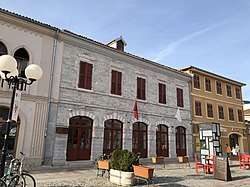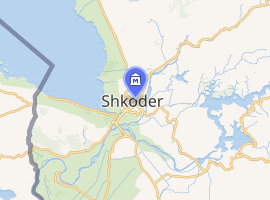National Museum of Photography "Marubi"
The National Museum of Photography "Marubi" (Albanian: Muzeu Kombëtar i Fotografisë "Marubi") or simply Marubi Museum is a national museum located in the northern city of Shkodër dedicated to Albanian photography and photographers.
Muzeu Kombëtar i Fotografisë "Marubi" | |
 The facade of the Marubi Museum | |

| |
| Established | 9 April 2016 |
|---|---|
| Location | Shkodër, Albania |
| Coordinates | 42°04′07″N 19°30′56″E |
| Type | Art Museum |
| Director | Luçjan Bedeni |
| Architect | Kolë Idromeno Casanova + Hernandez (reconstruction) |
| Owner | Government of Albania |
| Website | marubi |
The museum hosts a vast collection of 500,294 photographs of the Marubi's dynasty legacy from 1856 to 1989, including negatives, historical pictures and photographic objects and cameras belonging to three generations of photographers.[1] It begins back to 1856 when the first images were taken from Pietro Marubi in Albania, to the photographs from his apprentices Mati and Kel Kodheli (later Kel Marubi), and passing to Gegë Marubi's latest photos.[2] The museum also includes negatives from other Albanian photographers such as Shan Pici, Dedë Jakova and Pjetër Rraboshta.[3]
Background
.jpg)
The museum is mainly dedicated to the collection of Marubi Dynasty photographs, whose origins began with the arrival of the young Italian Pietro Marubi in the city of Shkodër in 1856. Pietro opened the first photography studio in Albania and also the first photo captured in the country, being the pioneer of Albanian photography for the years to come. The studio was called Dritëshkronja (literally translated: Lighted letter, meaning Written with the light) and the building has an outside sign stylized FOTO MARUBBI.[4]
His legacy, but also the passion and profession of the photographer, passed on to his apprentice Mikel Kodheli, who after Pietro's death changed his name to Kel Marubi in honor to his master and mentor. Kel became the legitimate inheritor of the studio, transforming it into a true art atelier. He enriched the photograph library with best-known figures of the time such as Gjergj Fishta, Migjeni, Ernest Koliqi, Shote Galica, Ded Gjo Luli, Bajram Curri, Fan Noli, Ahmet Zogu and others, as well as with photos from common people with characteristic national costumes, pictures from town and country life, landscapes and other aspects of Albania of the late 19th and the early 20th centuries. After Kel, the studio passed on to his son, Gegë Marubi, who was also the last of the dynasty.[5][6]
After the Communist Party came to power, and later on the abolishment of all private property, everything passed to the state.[7] The negatives of his predecessors, but also his own photographs passed into state ownership and many of them were donated to the General Directorate of Archives.[8] In 1949 the studio became state ownership and also his profession as a photographer was put to the service of the Communist State.[9] Many of the pre-regime photos in which prominent people of the Albanian state were photographed were manipulated to serve communist propaganda. The best example is the photos taken by Kel Marubi in occasion of the burial ceremony of the remains of the patriots Çerçiz Topulli and Mustafa Qulli in 1936, in which the personalities who had come out to the balcony of the Municipality of Shkodër to deliver speeches were all erased, showing only the Albanian dictator Enver Hoxha delivering a speech.[10]
After Gega's death in 1984, most part of the collection of photos, but also the negatives, objects he worked with, and the cameras used by him and his predecessors were stored in the General Directory of Archives. But after the fall of communism, another collection of photos and negatives stored by his family was discovered. Pictures that were strictly forbidden during communism, such as those featuring nudism or others that did not fit into the communist ideology of the time, were preserved secretly by him and after his death by the family.[9]
Building
.jpg)
Due to the vast number of photographs and negatives collected over the years by the General Directorate of Archives and the different periods of time that belonged to these photos, there was a need to build a proper building that would serve for their storage, preservation, restoration, and at the end their exposition to the public. In 2011 the Municipality of Shkodër became the initiator in its proposal to purchase a new building that would serve as the Marubi Museum. In December of the same year, the Albanian Government allocated a 55,000,000 ALL fund to purchase the building from the Kaçulini Family. Although the owners were offered higher amounts to buy the building, they agreed to negotiate with the Municipality of Shkodër to sell it to the Ministry of Culture to carry out a project for the Marubi Museum. The building itself is a historic two-storey building designed by Kolë Idromeno, a famous Albanian painter, sculptor, photographer, and architect born in Shkodër, who was a contemporary and great friend of the Marubi's. The building is located on the central boulevard of the city, but at that time the building was in a degraded status as a structure.[11]
In January 2014, with the initiation of the Albanian Development Fund and with the initiative of the Ministry of Culture, a competition was organized for the restoration of the building and the Dutch company Casanova + Hernandez Architects was selected as the winner.[12][1] The project presented preserved the basic historical character of the building, blending it with modernity, aimed to promote a rich dialogue between tradition and modernity, preserving its spatial and structural qualities are preserved without any volume transformation or new interior partitions.
Work began on the same year and expected completion was December of the following year.[13]
Permanent collection and temporary exhibitions
The Marubi Museum exhibits mainly as a permanent collection of photos taken by the Marubi Dynasty, but also photos that have been identified as photos of Lekë Voci, Lazër Kodheli, and Hilmi Mustafa, three Marubi's students who, with their objectives, photographed Albania's transition during the communist era.[1] In the permanent collection are as well included contemporary photographers, such as Shan Pici, Dedë Jakova and Pjetër Rraboshta.[3] There are a total of 500,294 photographs and negatives that were collected during the years 1856 to 1989, with over 150,000 belonging to the Marubi Dynasty.[14]
References
- "Fototeka Marubi mes të shkuarës dhe të ardhmes". reporter.al (in Albanian). 2015-02-12. Retrieved 2019-08-05.
- "Muzeu "Marubi", vizitorët kureshtarë për negativët e rrallë". Oranews. Retrieved 2019-08-02.
- "Muzeu Marubi, momenti i njëkohshëm europian në Shqipëri". Agjencia e Lajmeve SOT NEWS. 2016-05-10. Retrieved 2019-08-02.
- "L'epopea fotografica di Marubi si presenta a "Milano PhotoWeek"". Albania News (in Italian). 2017-06-23. Retrieved 2019-08-03.
- Chauvin, Loïc; Raby, Christian (2011). Dinasti Fotografësh Shqiptar. Ecrits de lumière. ISBN 9782953866940.
- "Dynasty Marubi – ein Fotostudio schreibt Geschichte". Zoom Fotoblog (in German). 2016-09-29. Retrieved 2019-08-03.
- "Albanian Communism". www.albaniantourist.com. Retrieved 2019-08-03.
- redazione. "Marubi National Museum of Photography". Fondazione Museo Pino Pascali | Polignano a Mare (BA) - ITALY. Retrieved 2019-08-03.
- ""Marubi", the first of a new generation of museums inaugurated in Shkoder". Qeveria Shqiptare Keshilli i Ministrave. Retrieved 2019-08-04.
- "Kur "armiqtë e popullit" hiqeshin nga fotografia". Gazeta Shqip (in Albanian). Retrieved 2019-08-03.
- "Marubi National Museum of Photography". urbannext.net. Retrieved 2019-08-05.
- "Projekti HERA". Fondi Shqiptar i Zhvillimit (in Albanian). Retrieved 2019-08-05.
- "Albanian-American Development Foundation". aadf.org. Retrieved 2019-08-04.
- "Marubi, a journey in the art of photography". Albania is the place. 2018-04-05. Retrieved 2019-08-05.
External links
| Wikimedia Commons has media related to Category:Marubi. |
